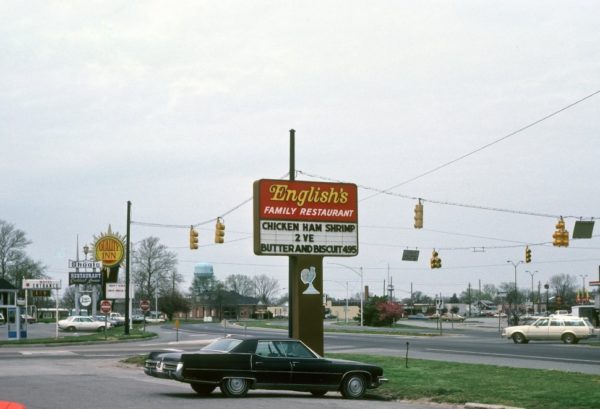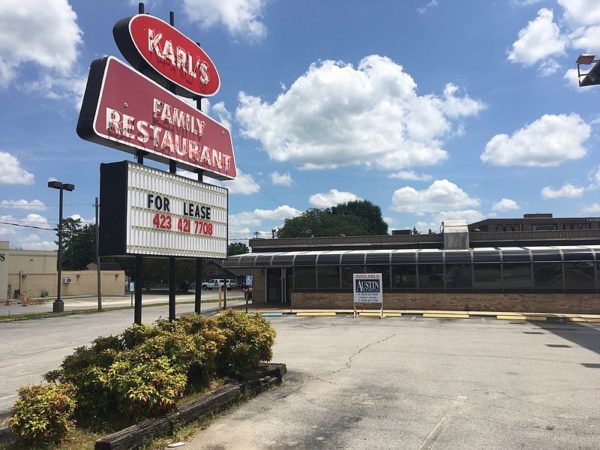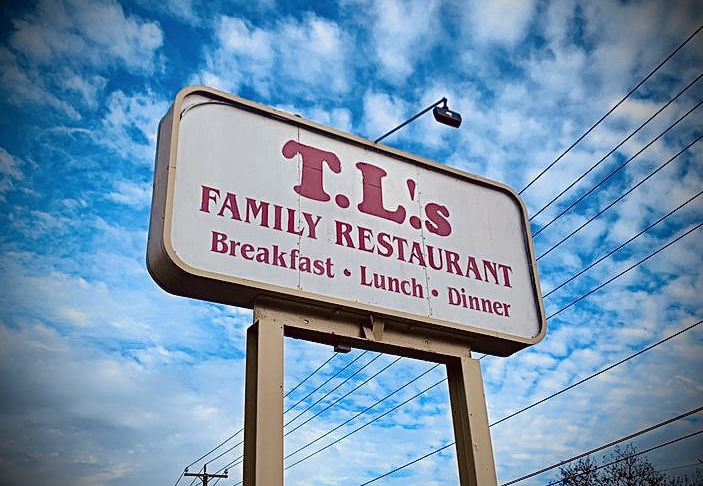Returning from a beach vacation in the Outer Banks of North Carolina, my family’s convoy stopped at an unassuming local spot just across the Roanoke Sound called T.L.’s Family Restaurant. Our weary group couldn’t stomach another gut-busting combo meal from Bojangles, so we settled on good old-fashioned American comfort food with sit-down service. From the parking lot, the restaurant looked like a community center or a pre-school, with a boxy roof and wide eaves that looked on the verge of collapsing. As we walked through the glass door at the entrance, I noticed the word restaurant misspelled (resteraunt). I’m guessing it’s been that way for decades. But the moment the scent of sizzling bacon hit my nostrils, I stopped proofreading.
The interior is well worn—more like a favorite t-shirt than a banged-up car—with nautical paraphernalia hanging on the walls and a giant stuffed swordfish over the kitchen window. Hungry locals come and go without urgency, mixed in with beach tourists and interlopers like us. The staff of mostly older women floats between tables with pots of piping hot coffee to keep everyone’s cups warm, greeting every new face cheerfully. I live in New York City, so these moments of southern hospitality are like taking a bath in lavender salts to a jaded urbanite like me.
“You ready to order, honey?” our waitress asks, referring to our party collectively as “honey.” She slips a small white pad out of her apron and sets it down on the ledge next to our table. Her movements are pure muscle memory, so routine that her body performs them automatically. Even though she doesn’t seem to be paying careful attention as we go around the table declaring our menu preferences, I feel confident she won’t make any mistakes. Experienced servers are unflappable—the great ones have been around long enough to be prepared for every possible scenario that could possibly happen in a restaurant. They don’t get flustered.
The menu at T.L.’s is comprehensive—omelets, sandwiches, salads, local fish, and entrees. Breakfast is an all-day affair, a proper feature of any beloved neighborhood eatery. I cavalierly order something called “Breakfast in a Bowl” for $10.95, which is served more literally than I expected—a mound of crumbled sausage, bacon, eggs, grits, and cheddar cheese formed over a gargantuan biscuit smothered in gravy. The food takes a while, but I remembered the caveat on the bottom of the menu: “This is not fast food, all our meals are cooked to order,” it read, “Please be patient or you can come in the kitchen and help.”

Family restaurants don’t have their own category in award shows, fancy food festivals, or “Best Of” listicles. I’m talking about places where you have a choice between a cup of soup or a bowl (which is usually cheddar broccoli made with a gallon of heavy cream). By definition, they offer Ranch or Thousand Island dressing with any salad, and not ironically. The hash browns are always crispy, seasoned with the carcinogenic flavor of a grimy griddle. Family restaurants are never chef-driven, vegetable-forward, farm-to-table, or nose-to-tail. Their secret sauce is choice (and to appeal to families, they often don’t serve alcohol). It’s the kind of restaurant where when the staff asks you “How was everything today?” they really mean it.
Obviously, any restaurant can be considered a family restaurant if families eat there, but I’m referring to a uniquely American institution, mostly found in small towns (the kind Jason Aldean sings about, minus the racist innuendo). Perhaps if it existed as its own culinary category, this cuisine could be identified as “Casual Caucasian.” There are, of course, other restaurants across the country, equally cherished, that cater to families—BBQ joints, pizza parlors, hot dog counters, taquerias—in communities of color and ethnic neighborhoods, but those are different. The bland flavor palate and the lived-in spaces of this kind of family restaurant has its own unique persona.
I can’t stand when the word family is co-opted to assign piety, the way the modern conservative movement has co-opted “family values.” No restaurant automatically becomes more sanctimonious simply because the word family is attached to its name. But there is something special about these timeless places that you can’t bottle, a patina that can only be earned by serving the community over a long and unhealthy lifetime. The family restaurant, in its purest form, is the restaurant equivalent of the dive bar. When it exudes the same grizzled charm, it deserves the same reverence.
Somewhere along the line in this country, we lost respect for the staying power of independent restaurants. Today, you can exit any interstate highway in the United States and find the same rotating cast of 8-10 chain restaurants repeated ad nauseam. Many of these corporate franchises, like Denny’s and Cracker Barrel, are designed to emulate the family restaurant esthetic.
Corporate restaurant groups are aggressively investing in small town growth. Last month on their quarterly earnings call, Chipotle executives revealed plans to open 800 new locations in cities with populations of under 40,000 people (or one-fifth of its total new stores) over the next few years. Expansion has become so rampant among chain restaurants in small towns, that corporate brands are beginning to cannibalize each others’ sales. But it hurts family-run restaurants the most. Choking off local competition is one of the oldest, dirtiest tricks in the corporate playbook. Multinational companies that run folksy places like Applebee’s and Ruby Tuesday can afford to lose money in the near term to focus on market share and building consumer habits. It’s the same way that Amazon prices goods below market (sometimes at a loss) and invests heavily in warehouse expansion to ensure we buy everything from them. Small restaurant businesses can’t afford the same near-sightedness.

The pandemic should have taught us that independent restaurants are the nervous centers of our communities and integral to the health of our local economies. Family-owned restaurants create better jobs and reinvest on the municipal level, while corporate monoliths siphon money out of communities to enrich shareholders. (Not to mention that many large restaurant companies also invest in robotics and artificial intelligence that will ultimately destroy jobs.) Family restaurants sponsor softball leagues, donate services to local charity events, host birthday parties, and support school districts. Corporate restaurants do nothing but create more corporate restaurants.
Over the course of my nourishing meal at T.L.’s (which I learned originally opened in 1999), I thought about the eroding restaurant landscape in the United States. It’s become a gaudy reflection of who we are, and who we aren’t. In our manic quest to chase food trends and score impossible reservations, we’ve lost the appreciation for restaurants that are just as good as they need to be. These days, the restaurants we say we love don’t all deserve our affection. They haven’t earned it. Too often, we mistake love for lust. We ignore struggling independent restaurants that desperately need our support, while at the same time, we wait in line for hours for cookie cutter versions of chain restaurants like Jollibee and In-and-Out.
The pandemic was the nail in the coffin of many independent family restaurants. To make matters worse, our insatiable appetite for corporate convenience food is shoveling dirt over their graves. When these cherished places close, new ones don’t pop up in their place. The American restaurant industry—with its combo meals and lab-tested recipes—is a monoculture of mass-produced mediocrity. Just as heirloom crops don’t thrive in over-farmed land with infertile soil, generational family businesses with strong rootstock can’t survive in a chicken finger economy. As with many man-made disasters like climate change and global warming, if we keep sponsoring the wrong kinds of business, we may not have any nice places to eat left.


And us independents were screwed over by gov. RRF. We spent money and went into debt with the promise of reimbursement for being forced to close from pandemic. Now we are struggling because its not business as usual, we are struggling, and saddled with debt. My restaurant is still only 50% of “normal” and we are faced with less traffic. The RRF money that should of been allocated by the number of years in business was handed out to corporate chains (Donors) and minorities first.